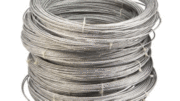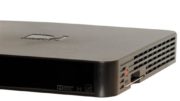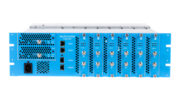You would never think a simple question like this would be so controversial. Yet, over the years I’ve nearly come to blows on this particular issue. There are a lot of opinions out there, and that’s because really there’s no “one-size-fits-all” answer. I’m going to teach you the way I learned it because, darn it, it’s my blog. This is probably the most cautious way of doing things, and caution is usually the right choice if you’re setting something up and leaving it behind for the customer.
Simple answer: 2 feet
You should never have a coaxial cable less than two feet. If your components are closer than that, make a two foot cable and loop it around neatly. It’s as simple as that. And now I’m going to tell you the more controversial part, which is why you shouldn’t have cables longer than that.
Think of the signal going through a cable as if it were water. Now think of the connector as if it were a funnel. Unless you’re careful, you’re going to slop a little water over the side of the funnel. We’ve all been there. Now, signals actually do act like this when they hit connectors, especially high-frequency signals. A small portion of the signal actually does hit the connector and bounce back, since there’s nowhere else for it to go. We call this a reflection.
Luckily, reflections dissipate pretty quickly. They head back up the cable, getting weaker and weaker with each passing inch. They start out roughly as strong as the original signal but very soon dissipate to nothingness. If you have a signal going through a cable that’s really short, the reflection hits the other connector and starts bouncing back. This can cause phase problems that degrade the original signal. So, you never want a cable that’s so short that the reflection could hit the other connector.
You also don’t want a cable that’s so short that if there’s reflections on the other side, that the two reflections hit each other. Because that would be mindbendingly bad. OK, it won’t cause a nuclear holocaust but it is going to really mess up the original signal. And then your customer will call and complain, and you’ll have to make a trip out there for free. Simply put, you don’t want that.
The higher the frequency, the longer the reflection. So what’s the longest reflection you’ll get on a typical coax cable in a satellite install? Turns out it’s about 11 inches. So, round that up to a foot. Because you don’t want the reflections to touch each other, you need a cable double that length. And that’s how you get that two foot number. Simple, right?
Or is it so simple?
Turns out there are folks who don’t agree with this. Some folks will tell you there is no minimum distance, you can have a 3″ cable if you really want. Others will agree with the two feet number, but give you different reasons for it. They’ll say it’s so the equipment can be easily replaced, or so the dielectric (the white inside part of a cable) isn’t too deformed when you’re making a cable. Someone will inevitably trot out some sort of really complex physics that I haven’t seen since the 11th grade to prove their point.
All I can say is, whatever. I’m telling you what I’ve been taught, and what I’ve done in the field. It’s served me well and if you follow my lead, it will serve you well too. And that, my friends, is the bottom line.
I know that there are adapters, like a male-to-male adapter, that are essentially very very short cables, and I have to believe that they are designed in such a way that reflections aren’t really an issue.
Shop at Solid Signal
Solid Signal is your source for pre-made cables, cable prep tools, and all the equipment and accessories you’ll need to make every installation perfect. Shop at our web site, where you’ll find pre-made cables as well as everything you need to make your own cables. Still not finding what you need? Call us at 888-233-7563 during East Coast business hours. We’re here to take care of you. If it’s after hours, fill out the form below and we’ll get back to you. It generally takes about one business day.





